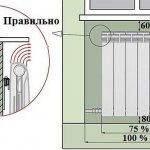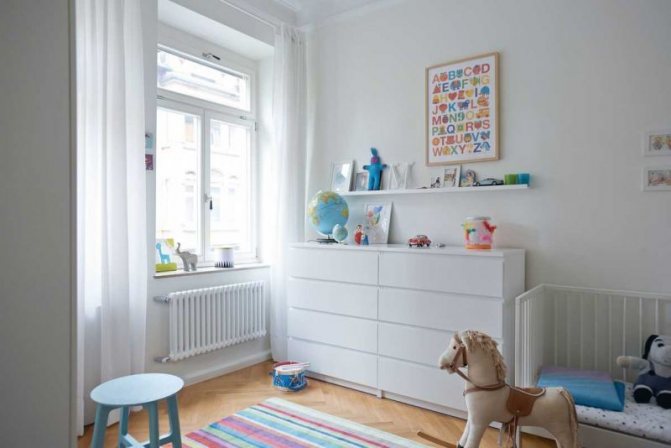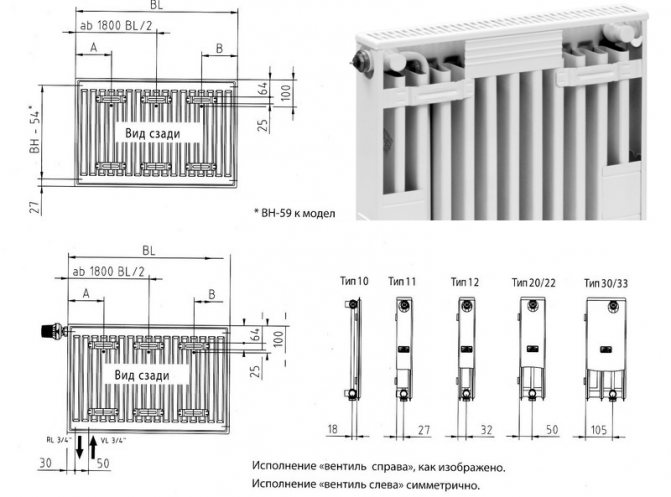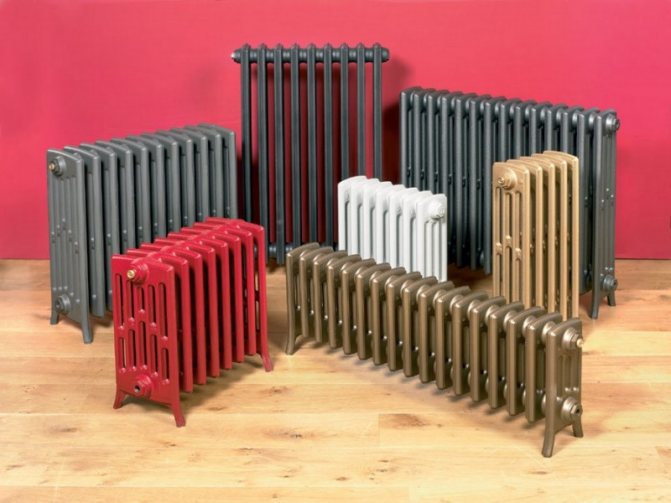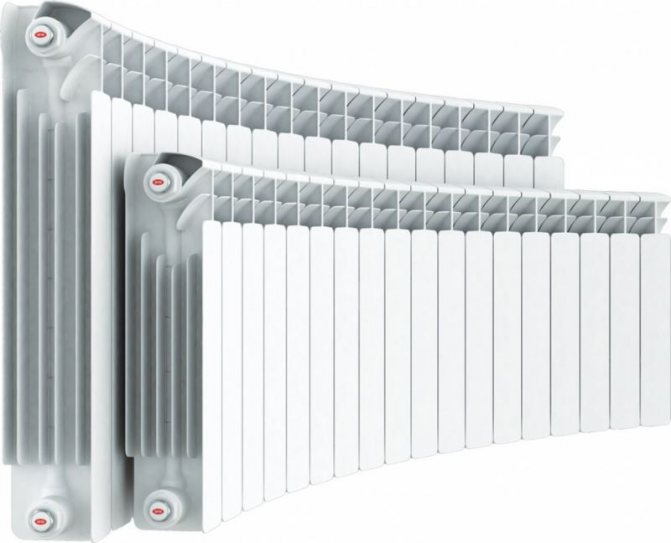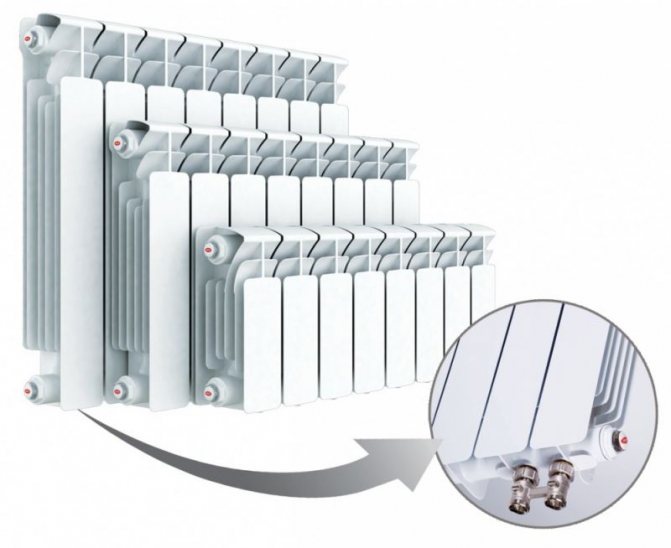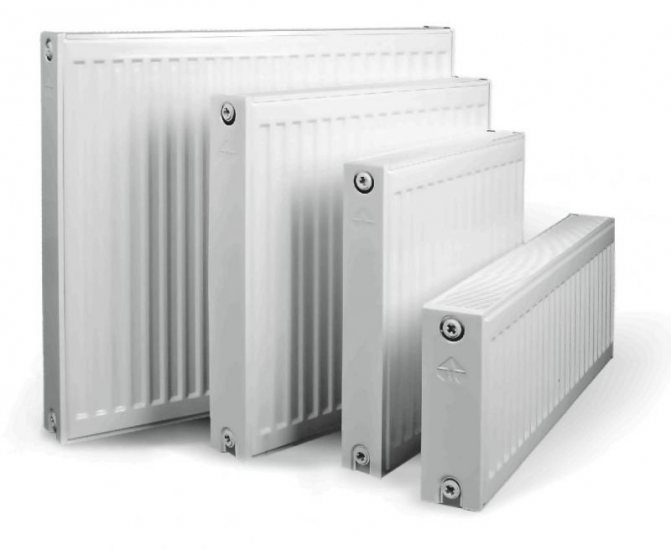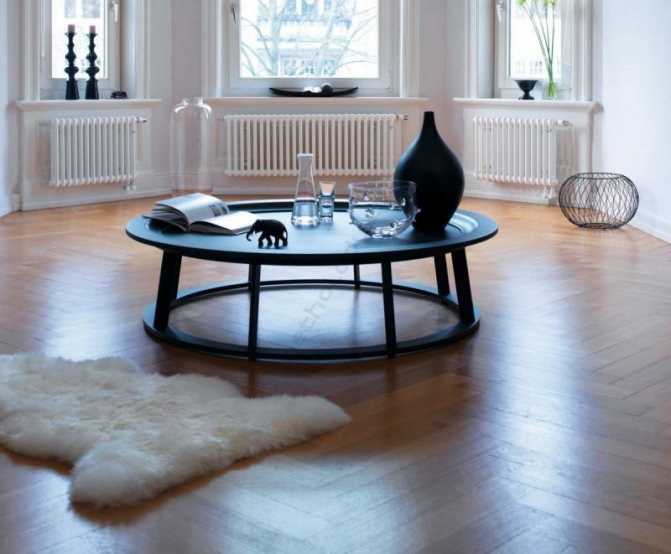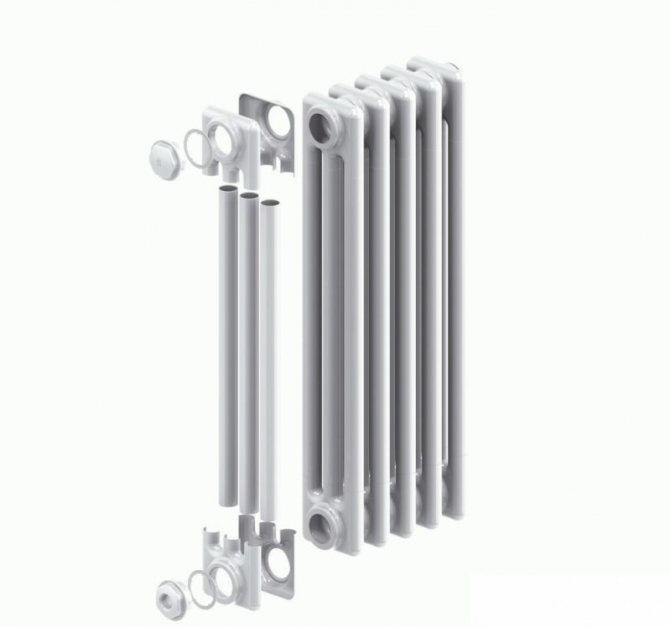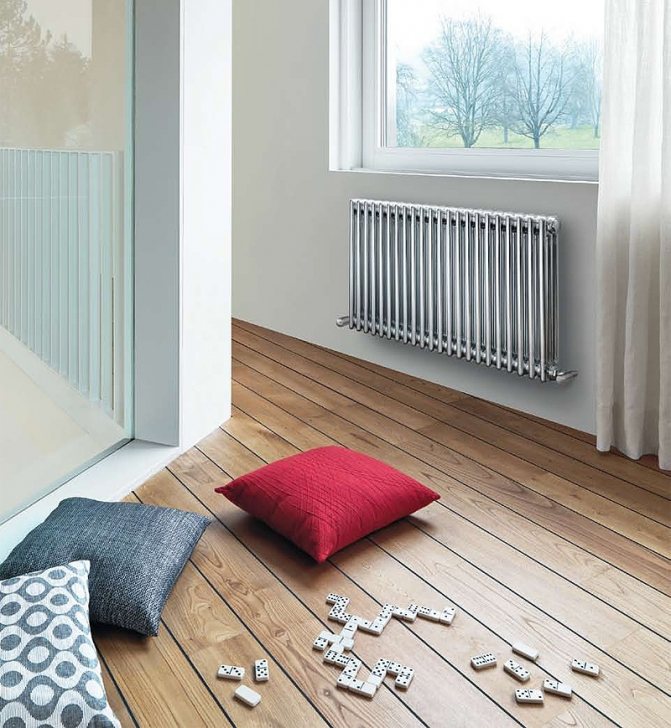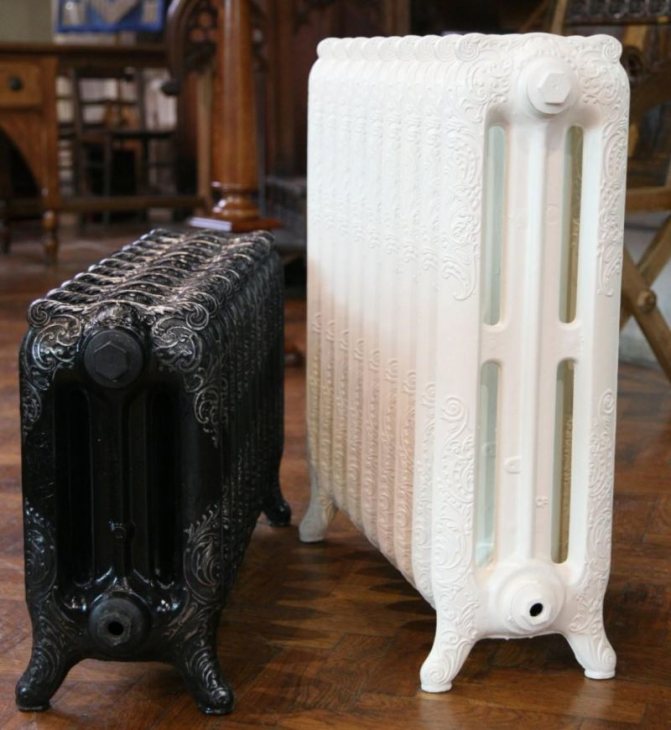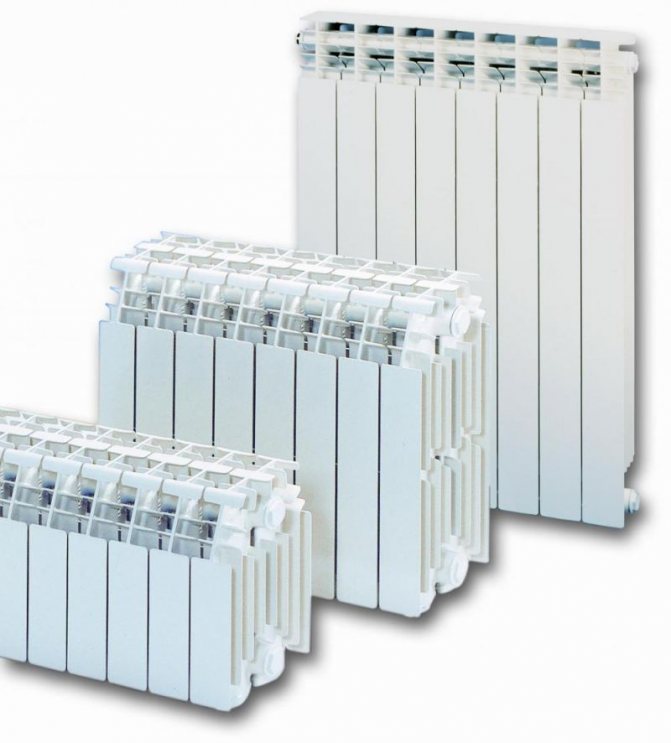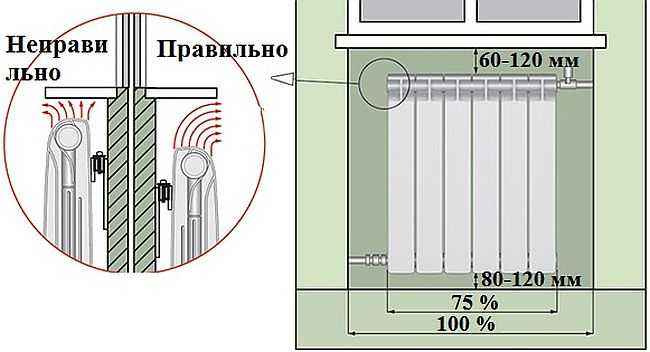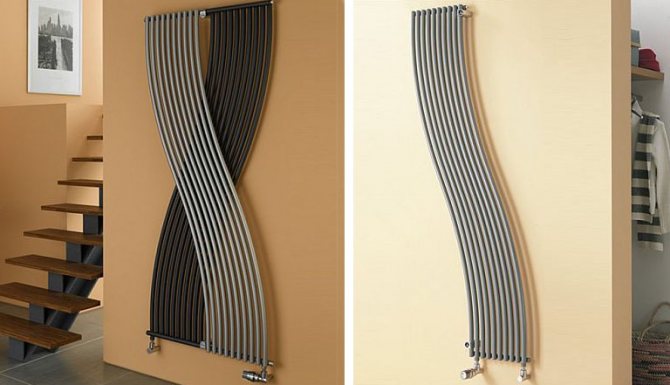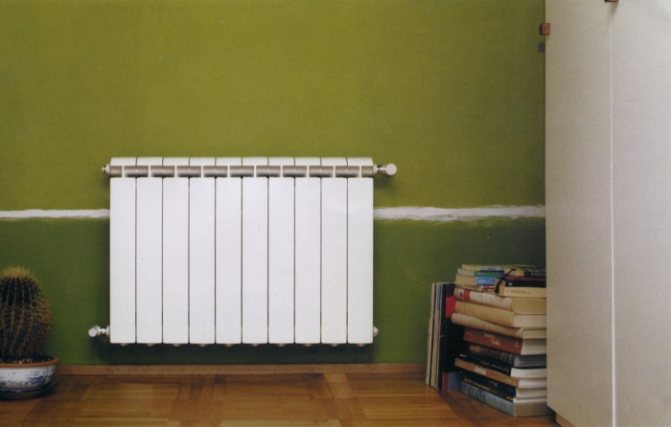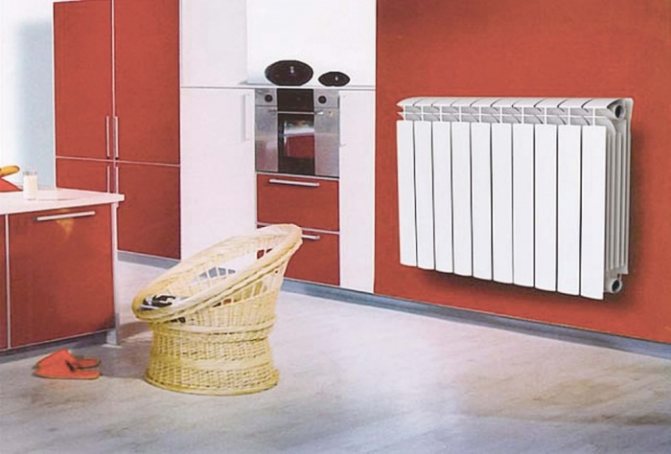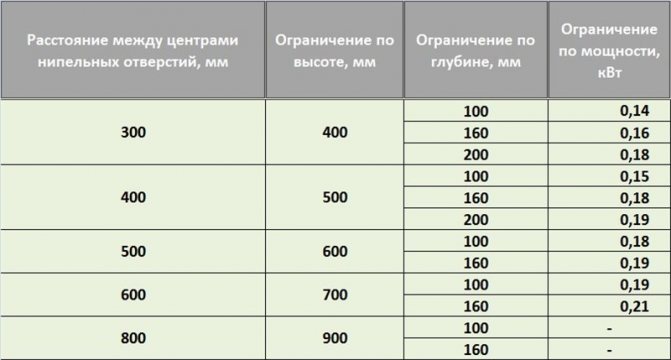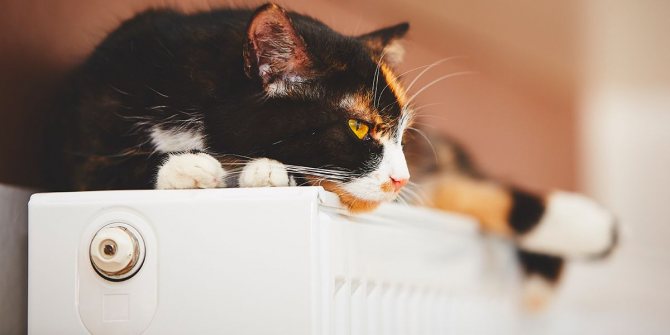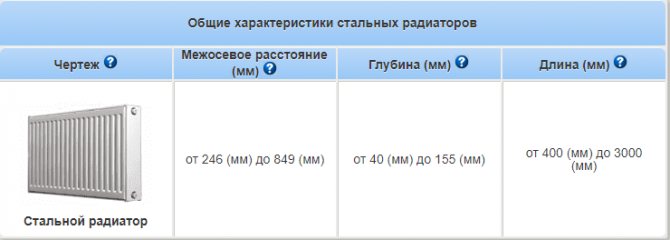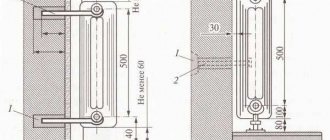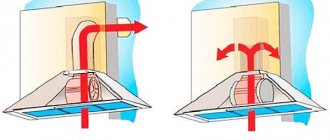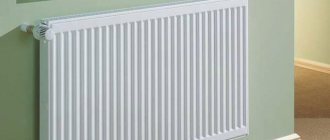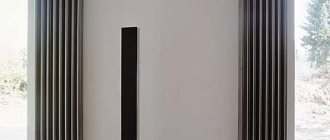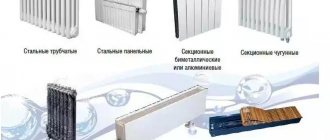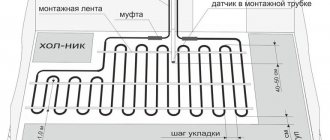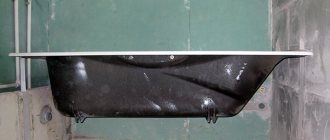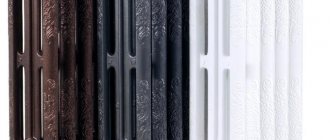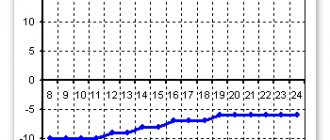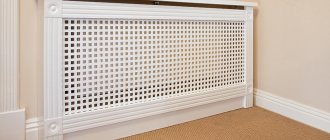What should be the dimensions of the radiators
The choice of the dimensions of heating devices is not based on aesthetic considerations. Heat transfer plays the main role here. This is especially true if a model is selected for installation under a window. You need to choose a model in such a way as to meet several requirements at once:
- the length of the radiator must cover at least 70-75% of the width of the window opening;
- the distance from the floor should be 80-120 mm;
- from the window sill 60-120 mm.

When choosing the dimensions of the radiator, you need to select them depending on how high the window sill is
Only under such conditions will the heat transfer of the heating device you choose be normal: it will give out the number of watts declared by the manufacturer.
Installation features


Installation diagram
The installation process for any type of radiator consists of a number of standard steps. First of all, they dismantle the old batteries, if any, and determine the places for placing the fasteners, on which the brackets are then fixed. At the second stage of installation, you need to prepare and hang the battery itself and install shut-off valves, then connect the pipes, observing the center-to-center distance in the radiators for heating. It is important to correctly select the size of heating batteries and install them correctly, regardless of size.
Radiators are placed strictly horizontally or with a slight slope, taking into account the direction of flow of the heat carrier. In the second case, when clogged, it will be easier to remove air plugs.
The batteries can be connected to the line from the bottom, from the side or diagonally; a separate valve and Mayevsky valve are placed on each device, which makes it possible to repair the radiator without the need to completely turn off the entire system. Appliances should be dimensioned in advance to determine their available power.
Terminology
Often in the descriptions and specifications there is the concept of "center distance". Sometimes the term "inter-nipple" and "inter-center" or connecting dimensions is found. These are different names for the same size. It is defined as the distance between the centers of the inlet openings of a section or a radiator.
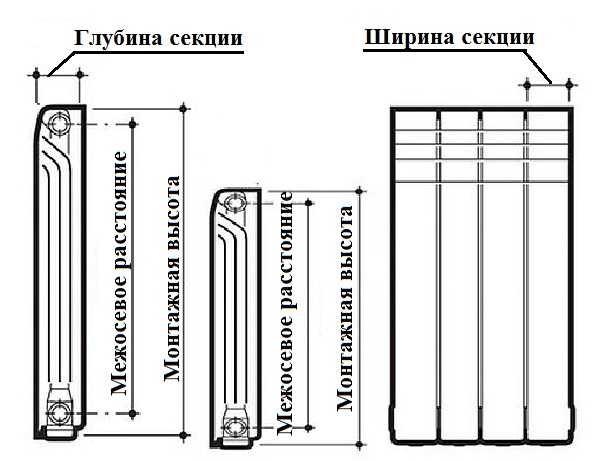

In the technical characteristics of radiators, there is often such a thing as the center distance
This parameter is important if the supply pipes are in good condition and there is no need to change them. In this case, in order not to digest the eyeliner, you can choose a model with the same center-to-center distance as the old radiators.
The overall dimensions of the section itself or the radiator are described by the following parameters:
- mounting height;
- depth;
- width.
If the radiator has a sectional structure, then the depth and width refer to the dimensions of the section. Moreover, the depth of the radiator will be the same, and the width of the battery depends on the required number of sections (you need to add about 1 cm more to the gaskets that fit for tightness of the joints).
The names of radiators often contain numbers: RAP-350, Magica 400, Rococo 790 or RAP-500. The numbers are the center distance indicated in millimeters. This makes it easier for both the buyer and the seller to navigate. The fact is that with the same center distance, the mounting height can differ significantly. Therefore, the specification is set to the most accurate value.
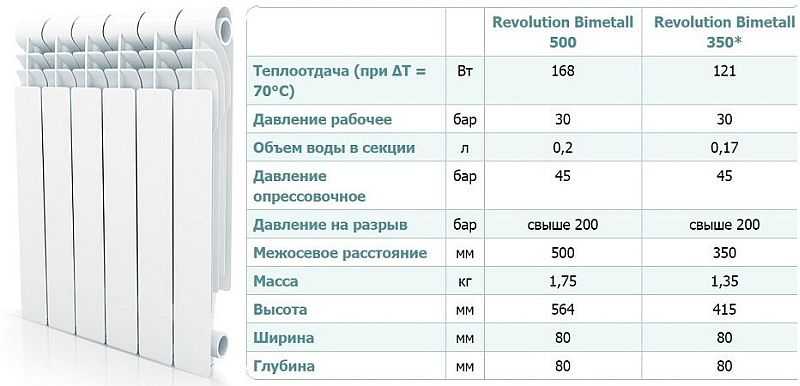

An example of technical characteristics. This is the Revolution Bimetall model
The radiator parameters that need to be taken into account include the volume of water in the section. For apartments connected to centralized heating, this characteristic does not affect anything, but for individual systems it is important: when it is necessary to calculate the volume of the system (to determine the boiler performance or pump characteristics).
And the most important, perhaps, parameter is thermal power. It should be noted that the highest power is not always necessary. Increasingly, in apartments and houses with good thermal insulation, heating devices of medium power are required, and not huge.
When selecting the thermal power of one section, it must be remembered that the radiator under the window must cover at least 75% of the width of the window opening. Then the room will be warm, there will be no cold zones and the glass will not "sweat". Therefore, it is better to take 10 less powerful sections than 6 pieces with high heat output.
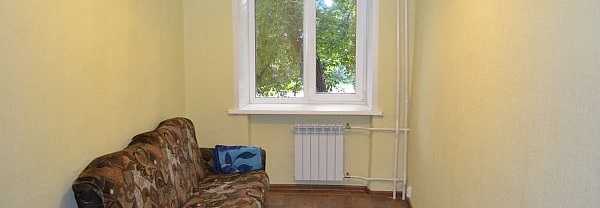

Such a radiator may deliver the required power, but there will be clearly cold and warm zones in the room.
The standard window width is 1100-1200 mm. Accordingly, 75% is 825-900 mm. This is the length or more your battery should be. Running a little ahead, let's say that the average width of one section of an aluminum radiator is 80 mm, which means that you need 10-12 sections.
What are the dimensions of heating devices?
There are generally accepted standard sizes: thickness - 9 cm, width - from 40 cm, height - 76, 94 and 112 cm. However, the linear parameters of heating radiators can vary significantly. Their dimensions depend on the material from which they are made and on their design.
By thickness (depth)
The thickness of heating radiators depends on the materials from which they are made and their shape:
- If you want to install thinner devices, then in terms of material, cast-iron and bimetallic devices are clearly inferior: the former due to rather thick walls, and the latter due to the double layer of metal.
- The shape also affects the thickness. The thinnest are panel devices: the thickness of steel and aluminum panels does not exceed 1 cm.
By width
The width of the battery is also different: both small (less than 40 cm) and much larger - up to 1.5 m, which can be very convenient when planning a room with restrictions on the place for their placement.
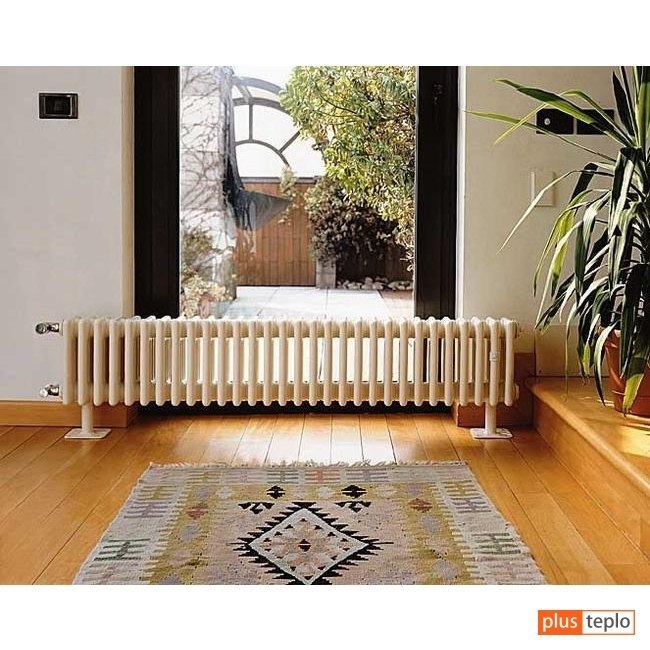

The original solution for "wide" heating
Remember! To maintain the heat balance in the room, when the width of the heating device decreases, its height or the number of installed sections must be increased.
Height
Here the sizes of radiators vary in the widest range - from 15 cm to 3 meters. Differ:
- Standard. The height of standard cast iron batteries is 588 mm, aluminum sections - 575 mm, bimetallic - 550-580 mm.
- Low. The height of "low" cast-iron batteries can be about 35 cm, and aluminum ones - 15 cm. They have an enviable advantage of being placed under low windowsills. An innovation is the so-called "plinth" radiators offered by some companies, the height of which can be only about 2 - 3 cm.
- Tall, or vertical with a small width, can reach 2 or 3 meters in height. They are installed in places where there is no suitable space for standard heating, but large volumes of air need to be heated. They are considered decorative, have ample design possibilities.
Interesting! The lower units have slightly more heat transfer. This is due to the minimization of the contact of warm air with the upper part of the device and the high heat flux from the fin surface.
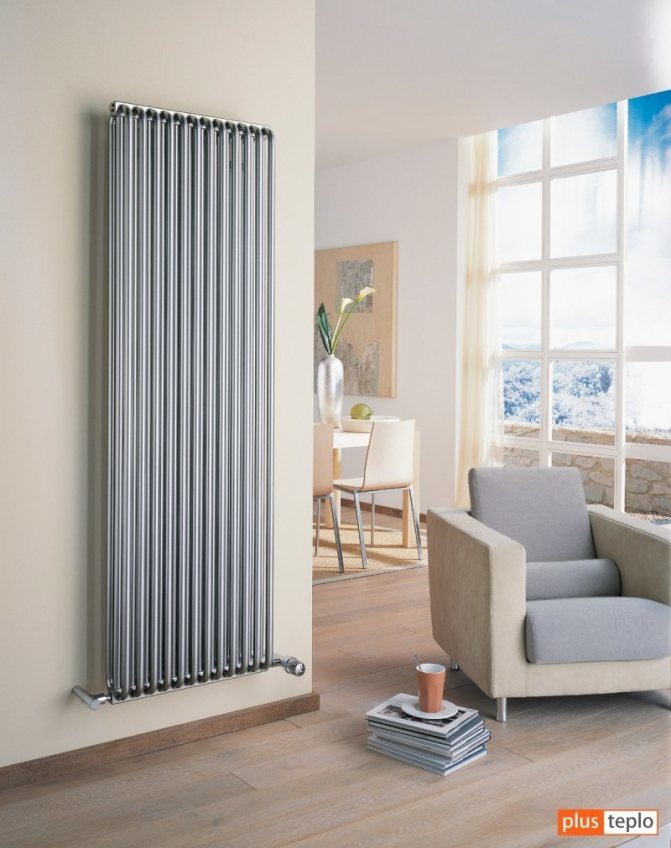

High vertical instrument
Standard height
When talking about the standard height, they mean a center distance of 500 mm. These are the connecting dimensions that the well-known cast-iron "accordion" of Soviet times had. And since they have a long service life, these batteries are still in heating networks. Only now they are being replaced with new ones. Moreover, they often do not want to redo the system, so they are looking for heating devices of the same size. What's good: they are in almost every group.
Cast iron
Today, not only the "accordion" is made of cast iron, although there is one and it is a success. There are also retro-style radiators with a center distance of 500 mm, made in a modern style:
- "Accordion" is called MS-140, MS-110, MS-90 and MS-85.These modifications differ in depth: 140, 110, 90 and 85 mm, respectively. The width is also different. Moreover, it differs from different manufacturers of the same model. So the MS-140 of the Minsk plant has a width of 108 mm, and of the Bryansk and Novosibirsk ones - 93 mm.
- Cast iron radiators in a retro style with a center distance of 500 mm, the appearance and dimensions will be completely different. Let's say, the Modern 500 model. Sections with legs, dimensions 645 * 100 * 45 mm, without legs 572 * 100 * 45 mm, heat power 93 W. And the other DERBY M 500 has dimensions of 660 * 174 * 63 mm and a heat dissipation of 118 W (where the dimensions are designated as height * depth * width).
- Cast iron batteries of the new model also have a decent range of parameters. Turkish Demrad Ridem 3/500 - 572 * 98.2 * 60 mm, Demrad Ridem 4/500 - 572 * 134 * 60 mm. Czech Viadrus Style have the following dimensions: height 580 mm, width - 60 mm, depth is not indicated due to its non-linear shape (narrower at the top, wider at the bottom).

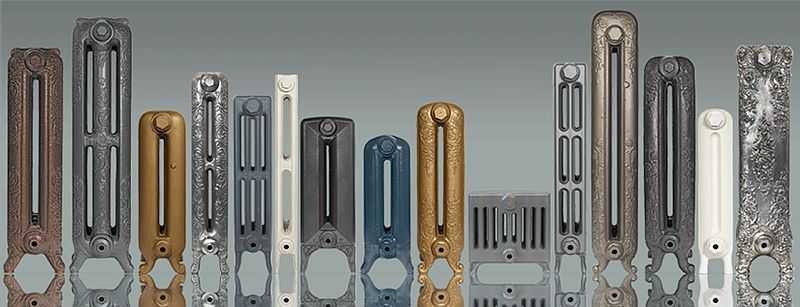
Cast iron batteries can have such dimensions today.
Aluminum
The dimensions of aluminum radiators are more standardized. Here you can even talk about average values. With a center-to-center distance of 500 mm, the average section height is 570-585 mm. Almost standard width is 80 mm. There are options in depth. There are practically flat ones: Russian-made "Thermal" radiators have a depth of only 52 mm. These are the flattest aluminum batteries. For all others, it is 80-100 mm.
Bimetallic
Here the situation is even more standard. There were no flat radiators in this category. On average, the dimensions are as follows: width 80-87 mm, depth 80-95 mm, height 565-575 mm.
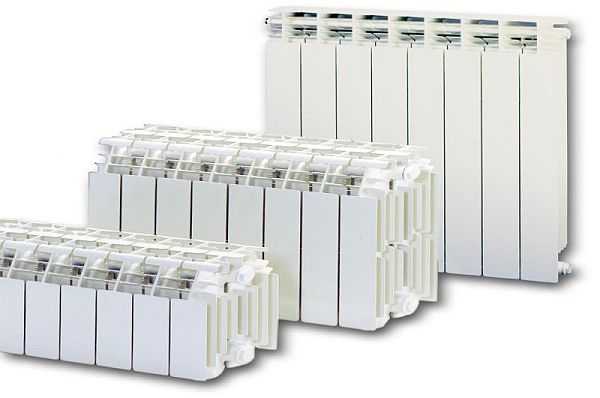

The lowest radiator at "Global" Gl-200/80 / D has a height of 200 mm
Steel
Steel panel radiators are rarely produced with a center distance of 500 mm. But still, there are some. For example, the Kermi campaign made the following connection sizes specially for the replacement: they are in the Plan-K and Profil-K line. There are also standard-sized radiators in the Russian one: the RSV-1 model.
Tubular radiators delight with an abundance of models and sizes. It is quite easy to find the required dimensions here. The Russian] KZTO [/ anchor] has it, the Europeans have it. In this category, they operate more with a total height - mounting, since many prefer a bottom connection.
Dimensions of bimetallic batteries
Bimetallic radiators are composed of a steel core and an aluminum housing. The main change that a steel core brings in comparison with an aluminum core is an increase in the permissible coolant pressure. Of course, the price goes up too. The most common sizes: 80-82x75-100x550-580 mm.
Heat transfer is slightly reduced due to the lower thermal conductivity of steel, however, it is compensated more by the ribbing of the section area. Heat transfer rates: 160-200 watts per section. The working pressure can be significantly yours: from 25 to 50 atmospheres.
For bimetallic radiators, the distribution of the same range of standard sizes is characteristic as for aluminum ones.
The dimensions of low aluminum radiators are typical for bimetallic ones. At the same time, the heat transfer characteristics also slightly change: radiators from 40 to 140 watts per section are common.
Bimetallic radiators, due to their higher performance characteristics, are more often used to build non-standard heating systems. In particular, such radiators are often used to stylize heating elements in the form of interior design elements.
Somehow it just doesn't make sense to evaluate standard sizes - they simply don't exist. Most European radiator manufacturers have their own range of radiators in a wide variety of, often exotic, sizes.
Tall and narrow
High radiators, even in the usual design, look unusual. And if you paint it in a non-standard color, give it an unusual shape, combine it with a mirror or a shelf, it turns out, in general, more like a designer thing than a banal heating device.
Let us immediately disappoint cast iron lovers: the highest cast-iron radiator is in the area of a meter. We have not met above. The same can be said about bimetallic ones - they cannot be higher than a meter. And in general, all that is in the bimetal is 760-860 mm or so.
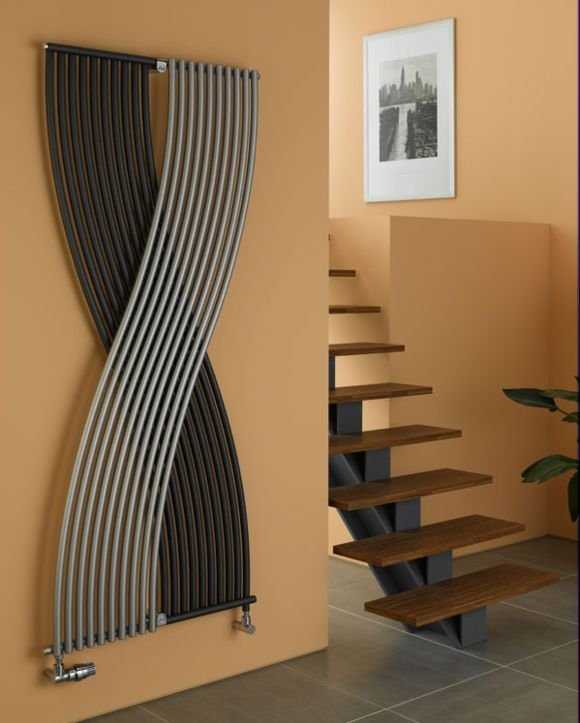

One of the most attractive models is the Arbonia Entreetherm vertical tubular radiator
Steel panel batteries as standard come in heights up to 900 mm. But there are also special models that can reach two meters and more. For example, Kermi has two models Verteo Plan and Verteo Profil - the maximum they can be up to 2.2 m. Purmo also has giants: Kos V, Faros V, Tinos V, Narbonne V and VT, Paros V. They differ in the type of front panel (smooth or profiled) and depth. But they all have only a bottom connection.
Steel tubular radiators are available up to 3000 mm high. Moreover, if necessary, some manufacturers can do higher. There are high models from any manufacturer: everyone who is present on the market offers such non-standard options "on order". Here we list only the most interesting in terms of design: Entreetherm, Planterm from Arbonia, Dekor series from Kermi, Harmony from Russian KZTO, Charleston from Zender.
There are no tall radiators in other types. The choice, and so, I must say, is considerable. I would not be at a loss.
Low radiators
All heaters, the center distance of which is less than 400 mm, can be considered low. And here they offer many different models.
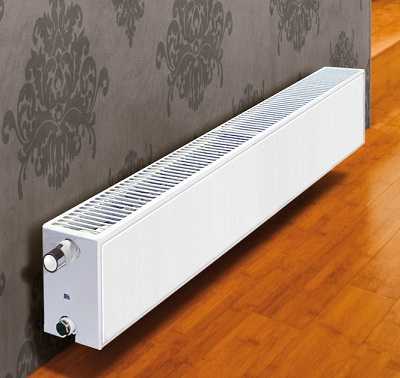

Steel panel radiators are very low
In the cast iron group, the minimum center distance for the BOLTON 220 model with an installation height of 330 m is slightly higher than the Hellas 270 from Viadrus: it has an installation height of 340 mm. All others are taller - with a center-to-center distance of 300-350 mm or so.
Among the aluminum radiators, the smallest have] Sira [/ anchor], their installation height is 245 mm, and the center-to-center height is 200 mm. These are the Alux and Rovall models with a depth of 80 mm and 100 mm. Similar dimensions have models from another well-known] Global [/ anchor] (Global) - model Gl-200/80 / D and the Russian "Rifar" - this is "Base 200" and "Forza 200".
All manufacturers have slightly larger aluminum batteries (with a center-to-center 300 mm and more). There is a wide choice.
The same Rifar and Sira have bimetallic low radiators: the heights are 245 mm and 264 mm, respectively. But most of all models have 350 mm connecting dimensions. Any manufacturer has them. Such a distance, in fact, can also be attributed to the standard - everyone has it.
There is even more choice in the group of steel radiators. The smallest panel panels are produced by Purmo - Purmo Planora and Ramo Compact - their center distance is 150 mm, and their height is 200 mm.
For all other manufacturers, the height starts from 300 mm. Moreover, the length can be up to 3 meters (the step of its change is 100 mm).
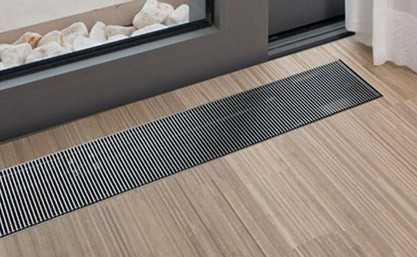

Floor radiators are the lowest possible
Tubular radiators are also very small: from 150 mm Delta Laserline sizes (manufactured by Purmo). In Arbonia, the height of all models of tubular radiators starts from 180 mm, in Zehnder from 190 mm (model Charleston), in the Russian KZTO from 300 mm.
There are low copper and copper-aluminum radiators. They are mainly produced in small dimensions - they have great power, and the price is also rather big. The lowest models are as follows: Ukrainian "Thermia" - height from 200 m, Polish Regulus-sistem - all models with height from 215 mm; Russian "IsoTerm" - from 215 mm; Chinese Mars (sectional type) with a height of 385 mm.
And the lowest can be considered the convectors built into the floor. They do not protrude above the floor level at all, but are placed for heating solid glazing, or built into the window sills of panoramic windows. There are they of different power and purpose, they can be used as additional or main heating.
Aluminum models
There are aluminum heating radiators, the dimensions in height and length are significant or small. But the most common options are such batteries with a center distance of 350 and 500 mm. Approximately 80% of all aluminum models on the market are of this height. But sometimes on sale there are also radiators with a center distance of 20-80 cm.
Recently, manufacturers have begun to produce very interesting skirting models of aluminum batteries. Visually, the dimensions of heating radiators of this type are very small.It's all about their low height. However, the length of such models can be quite large. If desired, very interesting vertical aluminum radiators can be found on the market today. For such models, the height can reach 2-2.5 m, and the width can be insignificant.
The depth of radiators of this type, like bimetallic ones, can be equal to 8 or 10 cm.The width of the section of an aluminum battery in most cases is 8 cm.
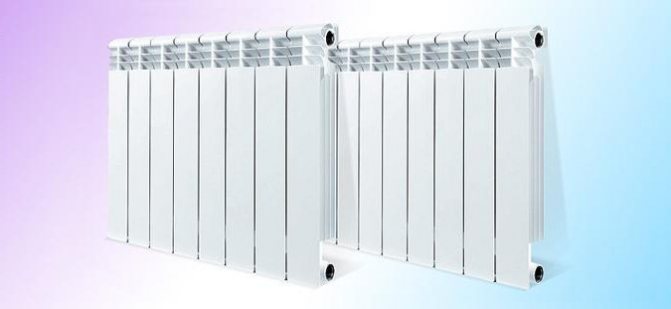

Flat radiators
In some cases, it is not the height, but the depth of the radiators that plays a role: flat batteries are needed. Here the choice is not very large.
Shallow depth aluminum radiators are produced by Zlatoust Thermal. Their RAP 500 and RAP 300 models have a depth of 52 mm, while the thermal power is decent - 161 W and 105 W.
Panel radiators can be considered flat: depending on the number of heating panels, they have a depth of 60 mm. Also the thickness is small.
A small depth happens in tubular steel radiators: two-pipe radiators are made with a thickness of 50 mm, three-pipe ones from 100 mm to 110 mm, all the others are already more solid - from 135 mm and more.
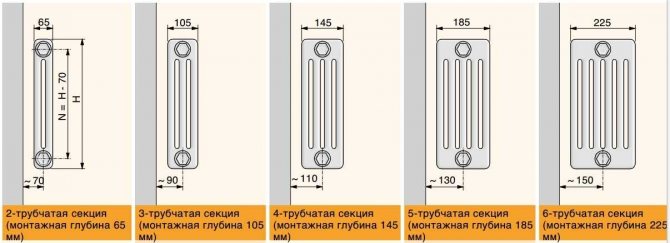

Steel pipe radiator can have from two to six columns of pipes
Neither bimetal, nor, especially cast iron, is flat. But there is a very good and perfect flat type of heating - a warm plinth. With such a system, heating devices are located along the floor along the perimeter. At the same time, their dimensions are about 30 mm in depth and 100-120 mm in height.

